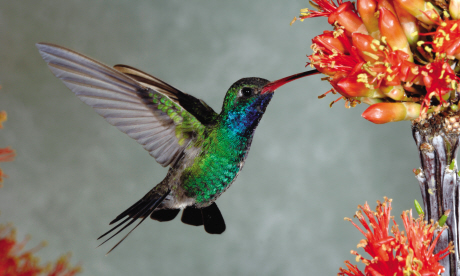
Wanderlust's wildlife expert Mark Carwardine gives a whole new meaning to feeding the birds while spotting hummers in Arizona
It was the first time I had ever worn make-up of any kind, let alone bright red lipstick. I felt like an extra in Moulin Rouge. My lips were puckered up and pointing to the sky; my fingers were crossed in the hope that nobody would see me. Oh, and my mouth was full of foul-tasting sugar-water.
I was hummingbird-watching and, apparently, this lipstick-donning was something of a tradition in hummingbird circles in certain parts of Arizona.
Within 30 seconds of applying my make-up, blurred shapes were whizzing backwards and forwards in front of my mouth. I nearly choked on the sugar-water and, wisely, the delicate, insect-like birds rapidly disappeared into the forest. Then one was back, this time hovering right in front of my mouth with the immaculate precision of an experienced helicopter pilot. I could feel its wingbeats against my cheeks as it carefully put its beak inside my mouth and drank.
Most nectar-giving flowers in the hummingbird world are bright red and, over the millennia, the hummers have learned to associate the colour with food. Whereas insects use scent to find their flowers, hummingbirds use their colour vision and can spot red petals (or lips) from far away.
I was on a ranch in south-eastern Arizona, some 1,800m up in the mountains near the Mexican border, with a spectacular view down a valley to the desert below.
Thousands of hummingbirds arrive on the ranch during spring, stay throughout the summer, then leave for warmer climes further south in early October. I saw no fewer than 11 species before breakfast on the first day, many of them from the bedroom window of my log cabin, including black-chinned, magnificent, blue-throated and broad-tailed specimens.
They were, however, unbelievably difficult to tell apart. I’m not particularly good at bird identification at the best of times, but hummingbirds actually change colour right in front of your eyes – they are the chameleons of the avian world. As they move around in relation to the sun, their bright, iridescent hues literally turn on and off. A rufous hummingbird, for instance, can look fiery-red head-on, but as it turns the colour shifts to orange, yellow, brown and ultimately green. It’s all very confusing. Meanwhile, the experts can identify them with their eyes closed – simply by the distinctive sounds of their miniscule wingbeats.
Hummingbirds have the fastest wingbeats of all birds. A typical North American species beats its wings up to 70 times per second in normal hovering flight. They are more like helicopters because, although they have to beat their wings to and fro instead of round and round, they are generating lift the whole time. One bird studied in a laboratory hovered continuously for no less than 50 minutes.
The drawback, of course, is that hovering uses a huge amount of energy (it’s the most energy-demanding activity in the animal world) and so the hummers have to drink huge quantities of energy-rich nectar – at least one and a half times their own body weight every day – in order to survive. They can never be far from their next meal and, as such, always live life on the edge.
Providing them with sufficient food is something of a national pastime in this corner of the US. In Arizona, it seems, every other house has sugar-water feeders, which look like upside-down jam jars, hanging in the backyard. I stayed at Beatty’s Miller Canyon Guest Ranch, which provides the birds with a mind-boggling 500kg of sugar every year. This is mixed one part sugar to four parts water and provided at special feeding stations dotted all over the ranch.
I spent hour after hour sitting quietly and watching dozens, probably hundreds, of birds stocking up on this ready supply of fuel.
I had always imagined them to be easy-going little Tinkerbells. But they were miniature fighter pilots – Samurai warriors, squabbling and fighting, intent on keeping the competition away from their favourite flowers. They’ve even been known to attack much larger birds in momentary fits of bad temper. If they were the size of ravens no one would be safe walking in the woods.
I surprised myself, too. I’ve spent most of my life working with sharks, whales and other leviathans of the animal world, but these diminutive birds took my breath away. They are so charismatic and so full of life that it’s impossible not to be captivated by them. I spent four days in their company and didn’t want to leave.